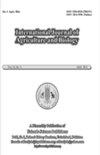丛枝菌根真菌通过激活氮碳代谢酶促进缺氮条件下高粱的生长
Q2 Agricultural and Biological Sciences
引用次数: 5
摘要
氮(N)是植物生长最重要的元素之一,植物需要大量的氮。然而,这种养分在土壤中的供应有限。丛枝菌根真菌(AMF)具有与植物形成共生关系并将矿质营养物质转移给寄主植物的能力。为了在高粱植株上验证这一假设,在低氮浓度(0.5 mM NH4+)条件下,对高粱3个生态型(3p4、3p9和4p11)进行了加和不加AMF的栽培。测定生长参数,测定氮碳代谢的关键酶如谷氨酰胺合成酶(GS)、谷氨酸脱氢酶(GDH)、磷酸烯醇丙酮酸羧化酶(PEPC)、异柠檬酸脱氢酶(ICDH)、苹果酸脱氢酶(MDH)和天冬氨酸转氨酶(AAT)。在3个生态型高粱中,菌根植株的生长均高于对照植株。生化指标显示氮同化酶显著升高;菌根植物叶片和根中的GS和GDH。此外,菌根真菌对碳同化酶也有显著的影响。众所周知,这些酶在提供铵的同化和氨基酸合成所必需的碳骨架中起着重要作用。我们的研究清楚地表明,AMF可以有效地优化植物对氮的吸收和同化,从而在较低的氮肥用量下提高作物产量。©2021朋友科学出版社本文章由计算机程序翻译,如有差异,请以英文原文为准。
Arbuscular Mycorrhizal Fungi Enhance Sorghum Plant Growth under Nitrogen-Deficient Conditions through Activation of Nitrogen and Carbon Metabolism Enzymes
Nitrogen (N), one of the most important elements for plant growth, is needed by plants in large quantities. However, this nutrient has limited supply in the soil. Arbuscular mycorrhizal fungi (AMF) are known for their ability to form symbiotic association with plants and transfer the mineral nutrients to the host plants. To validate this hypothesis on sorghum plants, three ecotypes of this cereal (3p4, 3p9 and 4p11) were cultivated with and without AMF under low nitrogen concentration (0.5 mM NH4+). Growth parameters were determined and key enzymes responsible for nitrogen and carbon metabolisms such as glutamine synthetase (GS), glutamate dehydrogenase (GDH), phosphoenolpyruvate carboxylase (PEPC), isocitrate dehydrogenase (ICDH), malate dehydrogenase (MDH) and asparate aminotransferase (AAT) were measured. For the three sorghum ecotypes, mycorrhizal plants showed a higher plant growth compared to the control plants. The biochemical parameters revealed a significant increase in the nitrogen assimilatory enzymes; GS and GDH in the leaves and roots of mycorrhizal plants. Furthermore, mycorrhizal fungi also appear to have a significant effect on carbon assimilatory enzymes. These enzymes are known to have a cardinal role in the provision of carbon skeletons essential for the assimilation of ammonium and thus, amino acids synthesis. Our study indicates clearly that AMF can be an efficient way to optimize nitrogen uptake and/or assimilation by plants and thus improve the crop yields with lower amount of nitrogen fertilizers. © 2021 Friends Science Publishers
求助全文
通过发布文献求助,成功后即可免费获取论文全文。
去求助
来源期刊

International Journal of Agriculture and Biology
AGRICULTURE, MULTIDISCIPLINARY-
CiteScore
1.70
自引率
0.00%
发文量
40
审稿时长
5 months
期刊介绍:
Information not localized
 求助内容:
求助内容: 应助结果提醒方式:
应助结果提醒方式:


